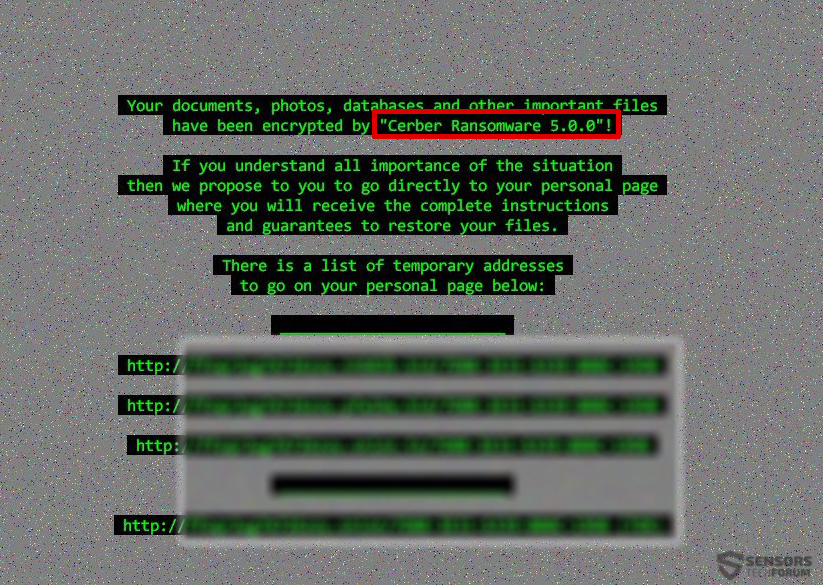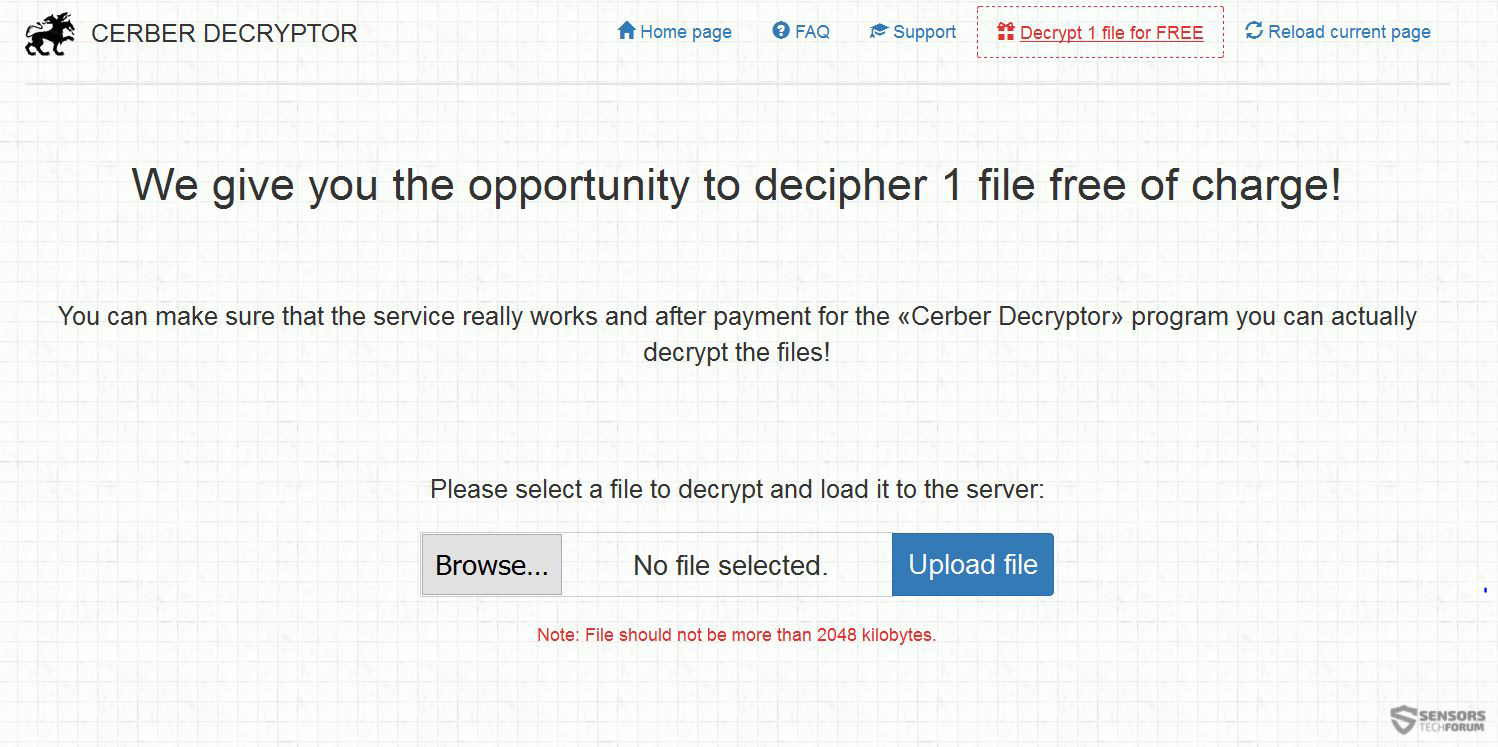 Malware researchers have recently detected the notorious Cerber ransomware to reach a new milestone, now calling itself 5.0.0. The new Cerber ransomware is distributed by the updated RIG-V exploit kit, which is regarded as a premium exploit using software for a higher infection rate. Malware researchers feel concerned that unlike the previous Cerber ransomware versions, this one is shaping up to be even more dangerous and more widespread. It has already begun causing infections and anyone who has become an unfortunate victim and has had their files encrypted should not pay any BitCoins to the cyber-criminals behind Cerber 5.0 and read this article to learn more about the virus plus how to remove it and try to recover your files.
Malware researchers have recently detected the notorious Cerber ransomware to reach a new milestone, now calling itself 5.0.0. The new Cerber ransomware is distributed by the updated RIG-V exploit kit, which is regarded as a premium exploit using software for a higher infection rate. Malware researchers feel concerned that unlike the previous Cerber ransomware versions, this one is shaping up to be even more dangerous and more widespread. It has already begun causing infections and anyone who has become an unfortunate victim and has had their files encrypted should not pay any BitCoins to the cyber-criminals behind Cerber 5.0 and read this article to learn more about the virus plus how to remove it and try to recover your files.
Image Source: feelgrafix.com

Threat Summary
| Name |
Cerber 5.0 |
| Type | Ransomware |
| Short Description | Cerber 5.0 causes encryption via a strong cipher to the files of the affected machine as well as it’s databases if it has any. Asks for payment in BitCoin for decryption. |
| Symptoms | The user infected by the 5.0 Cerber version may witness ransom notes and “instructions” as a wallpaper and an .hta file, linking to a web page which is in the Onion(TOR) network. The web page has a decryptor specifically for the infected computer which it offers to sell for BitCoin payoff. |
| Distribution Method | Via an Exploit kit, Dll file attack, malicious JavaScript or a drive-by download of the malware itself in an obfuscated manner. |
| Detection Tool |
See If Your System Has Been Affected by malware
Download
Malware Removal Tool
|
| User Experience | Join our forum to Discuss Cerber 5.0. |
| Data Recovery Tool | Windows Data Recovery by Stellar Phoenix Notice! This product scans your drive sectors to recover lost files and it may not recover 100% of the encrypted files, but only few of them, depending on the situation and whether or not you have reformatted your drive. |

Cerber 5.0 – What Is New
New RIG-V Exploit Kit Used To Infect
The most impactful modification of all of them in the new Cerber version is the RIG-V exploit kit that is being user with heavier obfuscation than the previously utilized in Cerber v4.1.6 RIG-E (Empire Pack). This exploit kit is reported by researchers at Malware-Traffic-Analysis to be somewhat a “VIP” version of the exploit kits.
It’s new modifications include a unique URL patterns and an increase obfuscation for the landing page which causes the infection. Researchers report that the exploit software uses RC4 encryption algorithm to obfuscate the payload and hence conceal it from any antivirus programs. The exploit kit is currently being used by two large hacking campaigns, belonging to the Afraidgate and pseudoDarkleech. The methodology of this exploit kit is that it may cause an infection via connection to a website that contains an auto-injection script. This is how malware researchers explain the infection process, similar to the one user in Cerber 5.0:

Source: Malware-Traffic-Analysis
And this compromised website may not only be a malicious URL that may be malvertised on a site or induced by a potentially unwanted program on your computer. It may also be send out as a different type of an HTML file, for example .hta(HTML application), .html, .htm. These types of files are usually posted in spam e-mails like the following Cerber spam message:
“Topic: Suspicious Bank Account Activity
Hello, we at your bank have been informed of a suspicious financial activity on your bank account. Please review the Document Number 3882-124442 from {date} for more information.
Best Regards
{Bank manager fake name}
{copied phone number}
{copied address of a bank office}”
After the user opens the malicious e-mail attachment which may either directly be carrying the exploit kit as an .exe type of file or carrying an HTML file both of which may be in a .ZIP archive, the infection becomes successful.
Cerber 5.0 Ransomware – Post-Infection Activity
After Cerber infects the user, the procedure is standard. It immediately begins inducing a privileged taskkill command in Windows Command Prompt to stop processes of databases. Here are some examples of such commands provided by Windows:
→ taskkill /pid 1230 /pid 1241 /pid 1253
taskkill /f /fi “USERNAME eq NT AUTHORITY\SYSTEM” /im notepad.exe
taskkill /s srvmain /f /im notepad.exe
taskkill /s srvmain /u maindom\hiropln /p p@ssW23 /fi “IMAGENAME eq note*” /im *
taskkill /s srvmain /u maindom\hiropln /fi “USERNAME ne NT*” /im *
taskkill /f /fi “PID ge 1000” /im *
These commands may allow Cerber 5.0 to stop MySQL, Oracle and Microsoft Access databases. In addition to this, the ransomware is also believed to attack the following registry subkeys, creating values with data which allows it to take over some components of Windows that give it permission to fully execute the malware and encrypt the databases plus various files:
HKEY_LOCAL_MACHINE\Software\Microsoft\Windows\CurrentVersion\RunServicesOnce
HKEY_LOCAL_MACHINE\Software\Microsoft\Windows\CurrentVersion\RunServices
HKEY_LOCAL_MACHINE\Software\Microsoft\Windows\CurrentVersion\RunOnce
HKEY_LOCAL_MACHINE\Software\Microsoft\Windows\CurrentVersion\Run
HKEY_CURRENT_USER\Software\Microsoft\Windows\CurrentVersion\Run
HKEY_CURRENT_USER\Software\Microsoft\Windows\CurrentVersion\RunOnce
HKEY_LOCAL_MACHINE\Software\Classes
HKEY_CURRENT_USER\Software\Classes
HKEY_LOCAL_MACHINE\SOFTWARE\Microsoft\Cryptography
After the modification is complete, the 5th version of Cerber begins to encrypt files, rendering them with changed file names and file extension to completely random A-Z, 0-9 symbols, looking like the following:
Not only the files can no longer be opened, but they are appended an encryption algorithm that produces a unique decryption key which corresponds to the decryptor of the ransomware virus being sold on Cerber’s Tor-based web page, linked in the wallpaper changed by the ransomware to notify the victim:
The web page of Cerber 5.0 ransomware is exactly the same as the 4.1.6 and the other older versions of Cerber, giving the possibility to pay approximately 500 dollars and a deadline to do it:

Cerber 5.0 – Conclusion, Removal and File Decryption or Restoration
As a bottom line, the creators of Cerber ransomware go in parallel timelines as the ones behind Locky ransomware, creating a new variant every time Locky comes up with a new one, suggesting competition or cooperation between the two hacking groups. But we will surely be seeing more and more versions of both the viruses, primarily because of the unimaginably large-scale spamming campaigns posted by the ransomware viruses. Affiliates of a ransomware virus belived to be Locky but undisclosed by authorities were arrested several weeks ago in the UK, suggesting that the actual creators of the ransomware are making money without even having to spread the malware themselves, but working with many cyber-criminals from all over the world to generate a percentage from every ransom paid.
It is strongly advisable to not cooperate with those cyber-criminals and not pay any type of ransom to them. Instead we advise you to immediately remove Cerber 5.0’s virus files from your computer, preferably using the instructions we have posted below. In case you lack the experience in manual removal of malware, we suggest doing this in an automatic manner, by downloading and scanning your computer with an advanced malware removal software.
After having removed Cerber 5.0, we urge you to take advantage of the website of Cerber which offers 1 free file decryption after which create copies of the encrypted files by Cerber so that you can try safely the alternative tools for file restoration we have suggested below. They are not 100% guarantee you will decrypt files but users have reported on our forums that using some of the methods they were able to restore a small portion of the files(10 to 50 files).
- Step 1
- Step 2
- Step 3
- Step 4
- Step 5
Step 1: Scan for Cerber 5.0 with SpyHunter Anti-Malware Tool



Ransomware Automatic Removal - Video Guide
Step 2: Uninstall Cerber 5.0 and related malware from Windows
Here is a method in few easy steps that should be able to uninstall most programs. No matter if you are using Windows 10, 8, 7, Vista or XP, those steps will get the job done. Dragging the program or its folder to the recycle bin can be a very bad decision. If you do that, bits and pieces of the program are left behind, and that can lead to unstable work of your PC, errors with the file type associations and other unpleasant activities. The proper way to get a program off your computer is to Uninstall it. To do that:


 Follow the instructions above and you will successfully delete most unwanted and malicious programs.
Follow the instructions above and you will successfully delete most unwanted and malicious programs.
Step 3: Clean any registries, created by Cerber 5.0 on your computer.
The usually targeted registries of Windows machines are the following:
- HKEY_LOCAL_MACHINE\Software\Microsoft\Windows\CurrentVersion\Run
- HKEY_CURRENT_USER\Software\Microsoft\Windows\CurrentVersion\Run
- HKEY_LOCAL_MACHINE\Software\Microsoft\Windows\CurrentVersion\RunOnce
- HKEY_CURRENT_USER\Software\Microsoft\Windows\CurrentVersion\RunOnce
You can access them by opening the Windows registry editor and deleting any values, created by Cerber 5.0 there. This can happen by following the steps underneath:


 Tip: To find a virus-created value, you can right-click on it and click "Modify" to see which file it is set to run. If this is the virus file location, remove the value.
Tip: To find a virus-created value, you can right-click on it and click "Modify" to see which file it is set to run. If this is the virus file location, remove the value.
Before starting "Step 4", please boot back into Normal mode, in case you are currently in Safe Mode.
This will enable you to install and use SpyHunter 5 successfully.
Step 4: Boot Your PC In Safe Mode to isolate and remove Cerber 5.0





Step 5: Try to Restore Files Encrypted by Cerber 5.0.
Method 1: Use STOP Decrypter by Emsisoft.
Not all variants of this ransomware can be decrypted for free, but we have added the decryptor used by researchers that is often updated with the variants which become eventually decrypted. You can try and decrypt your files using the instructions below, but if they do not work, then unfortunately your variant of the ransomware virus is not decryptable.
Follow the instructions below to use the Emsisoft decrypter and decrypt your files for free. You can download the Emsisoft decryption tool linked here and then follow the steps provided below:
1 Right-click on the decrypter and click on Run as Administrator as shown below:

2. Agree with the license terms:

3. Click on "Add Folder" and then add the folders where you want files decrypted as shown underneath:

4. Click on "Decrypt" and wait for your files to be decoded.

Note: Credit for the decryptor goes to Emsisoft researchers who have made the breakthrough with this virus.
Method 2: Use data recovery software
Ransomware infections and Cerber 5.0 aim to encrypt your files using an encryption algorithm which may be very difficult to decrypt. This is why we have suggested a data recovery method that may help you go around direct decryption and try to restore your files. Bear in mind that this method may not be 100% effective but may also help you a little or a lot in different situations.
Simply click on the link and on the website menus on the top, choose Data Recovery - Data Recovery Wizard for Windows or Mac (depending on your OS), and then download and run the tool.
Cerber 5.0-FAQ
What is Cerber 5.0 Ransomware?
Cerber 5.0 is a ransomware infection - the malicious software that enters your computer silently and blocks either access to the computer itself or encrypt your files.
Many ransomware viruses use sophisticated encryption algorithms to make your files inaccessible. The goal of ransomware infections is to demand that you pay a ransom payment to get access to your files back.
What Does Cerber 5.0 Ransomware Do?
Ransomware in general is a malicious software that is designed to block access to your computer or files until a ransom is paid.
Ransomware viruses can also damage your system, corrupt data and delete files, resulting in the permanent loss of important files.
How Does Cerber 5.0 Infect?
Via several ways.Cerber 5.0 Ransomware infects computers by being sent via phishing emails, containing virus attachment. This attachment is usually masked as an important document, like an invoice, bank document or even a plane ticket and it looks very convincing to users.
Another way you may become a victim of Cerber 5.0 is if you download a fake installer, crack or patch from a low reputation website or if you click on a virus link. Many users report getting a ransomware infection by downloading torrents.
How to Open .Cerber 5.0 files?
You can't without a decryptor. At this point, the .Cerber 5.0 files are encrypted. You can only open them once they are decrypted using a specific decryption key for the particular algorithm.
What to Do If a Decryptor Does Not Work?
Do not panic, and backup the files. If a decryptor did not decrypt your .Cerber 5.0 files successfully, then do not despair, because this virus is still new.
Can I Restore ".Cerber 5.0" Files?
Yes, sometimes files can be restored. We have suggested several file recovery methods that could work if you want to restore .Cerber 5.0 files.
These methods are in no way 100% guaranteed that you will be able to get your files back. But if you have a backup, your chances of success are much greater.
How To Get Rid of Cerber 5.0 Virus?
The safest way and the most efficient one for the removal of this ransomware infection is the use a professional anti-malware program.
It will scan for and locate Cerber 5.0 ransomware and then remove it without causing any additional harm to your important .Cerber 5.0 files.
Can I Report Ransomware to Authorities?
In case your computer got infected with a ransomware infection, you can report it to the local Police departments. It can help authorities worldwide track and determine the perpetrators behind the virus that has infected your computer.
Below, we have prepared a list with government websites, where you can file a report in case you are a victim of a cybercrime:
Cyber-security authorities, responsible for handling ransomware attack reports in different regions all over the world:
Germany - Offizielles Portal der deutschen Polizei
United States - IC3 Internet Crime Complaint Centre
United Kingdom - Action Fraud Police
France - Ministère de l'Intérieur
Italy - Polizia Di Stato
Spain - Policía Nacional
Netherlands - Politie
Poland - Policja
Portugal - Polícia Judiciária
Greece - Cyber Crime Unit (Hellenic Police)
India - Mumbai Police - CyberCrime Investigation Cell
Australia - Australian High Tech Crime Center
Reports may be responded to in different timeframes, depending on your local authorities.
Can You Stop Ransomware from Encrypting Your Files?
Yes, you can prevent ransomware. The best way to do this is to ensure your computer system is updated with the latest security patches, use a reputable anti-malware program and firewall, backup your important files frequently, and avoid clicking on malicious links or downloading unknown files.
Can Cerber 5.0 Ransomware Steal Your Data?
Yes, in most cases ransomware will steal your information. It is a form of malware that steals data from a user's computer, encrypts it, and then demands a ransom in order to decrypt it.
In many cases, the malware authors or attackers will threaten to delete the data or publish it online unless the ransom is paid.
Can Ransomware Infect WiFi?
Yes, ransomware can infect WiFi networks, as malicious actors can use it to gain control of the network, steal confidential data, and lock out users. If a ransomware attack is successful, it could lead to a loss of service and/or data, and in some cases, financial losses.
Should I Pay Ransomware?
No, you should not pay ransomware extortionists. Paying them only encourages criminals and does not guarantee that the files or data will be restored. The better approach is to have a secure backup of important data and be vigilant about security in the first place.
What Happens If I Don't Pay Ransom?
If you don't pay the ransom, the hackers may still have access to your computer, data, or files and may continue to threaten to expose or delete them, or even use them to commit cybercrimes. In some cases, they may even continue to demand additional ransom payments.
Can a Ransomware Attack Be Detected?
Yes, ransomware can be detected. Anti-malware software and other advanced security tools can detect ransomware and alert the user when it is present on a machine.
It is important to stay up-to-date on the latest security measures and to keep security software updated to ensure ransomware can be detected and prevented.
Do Ransomware Criminals Get Caught?
Yes, ransomware criminals do get caught. Law enforcement agencies, such as the FBI, Interpol and others have been successful in tracking down and prosecuting ransomware criminals in the US and other countries. As ransomware threats continue to increase, so does the enforcement activity.
About the Cerber 5.0 Research
The content we publish on SensorsTechForum.com, this Cerber 5.0 how-to removal guide included, is the outcome of extensive research, hard work and our team’s devotion to help you remove the specific malware and restore your encrypted files.
How did we conduct the research on this ransomware?
Our research is based on an independent investigation. We are in contact with independent security researchers, and as such, we receive daily updates on the latest malware and ransomware definitions.
Furthermore, the research behind the Cerber 5.0 ransomware threat is backed with VirusTotal and the NoMoreRansom project.
To better understand the ransomware threat, please refer to the following articles which provide knowledgeable details.
As a site that has been dedicated to providing free removal instructions for ransomware and malware since 2014, SensorsTechForum’s recommendation is to only pay attention to trustworthy sources.
How to recognize trustworthy sources:
- Always check "About Us" web page.
- Profile of the content creator.
- Make sure that real people are behind the site and not fake names and profiles.
- Verify Facebook, LinkedIn and Twitter personal profiles.


















I just got this virus on my work computer opening an email with a “job applicant” resume attached. I was 50/50 suspecting foul play but still opened it. If i have thousands of work related files that I need decryption, doesn’t it make sense to pay the $500 and cut my losses?
Hi Andrey,
Unfortunately, there is no guarantee that you will get a decryption key. After all, don’t forget that you are dealing with cyber criminals. In addition, ransomware payments monetize infections and further enable criminals. We suggest you invest in data recovery software.
From what I’ve read, there is no recovery software that actually recovers everything. Would the software actually rename all of my files to the proper names and extensions or file formats? And is it automatic? Or would it be a lot of manual work? Which software would you recommend?
You are right, no recovery software can recover absolutely everything, but some recover more than others. The software won’t rename your files, but check if their originals have been deleted and recover those. It is automatic, you just have to hit a button to scan, and then choose what to recover from the program’s findings (this could be different for different programs). You could start by trying a free tool like Recuva to see how the software works. Get back to us if you have more questions.